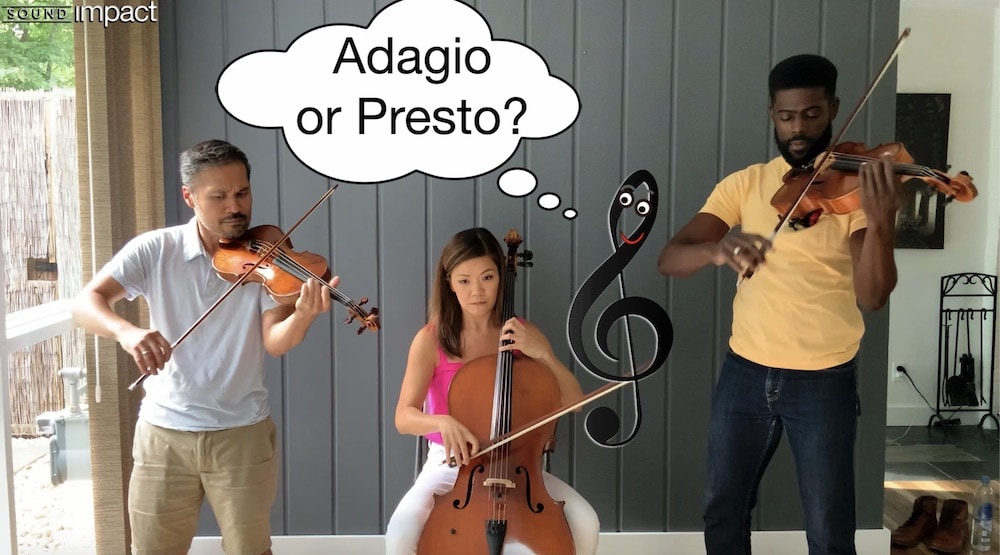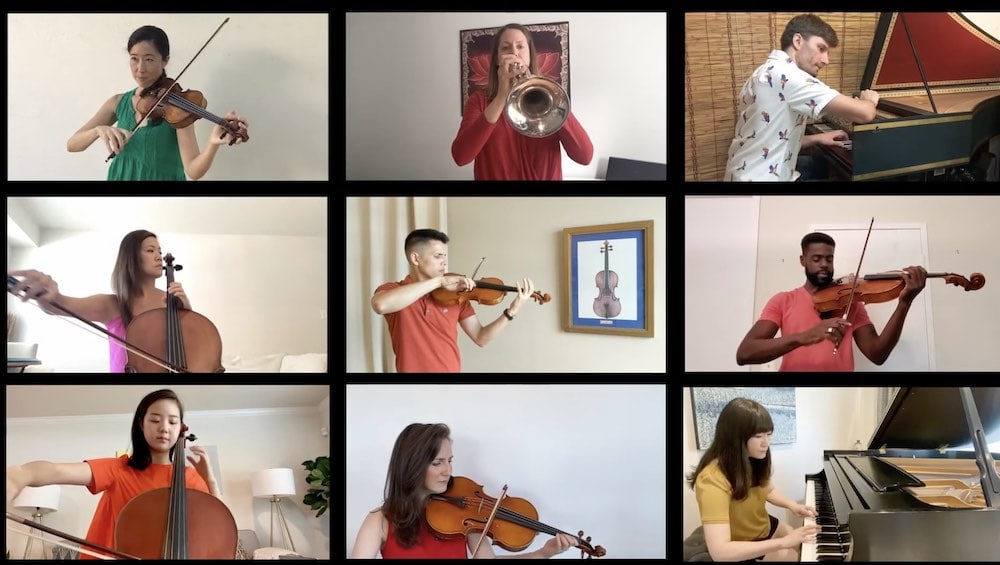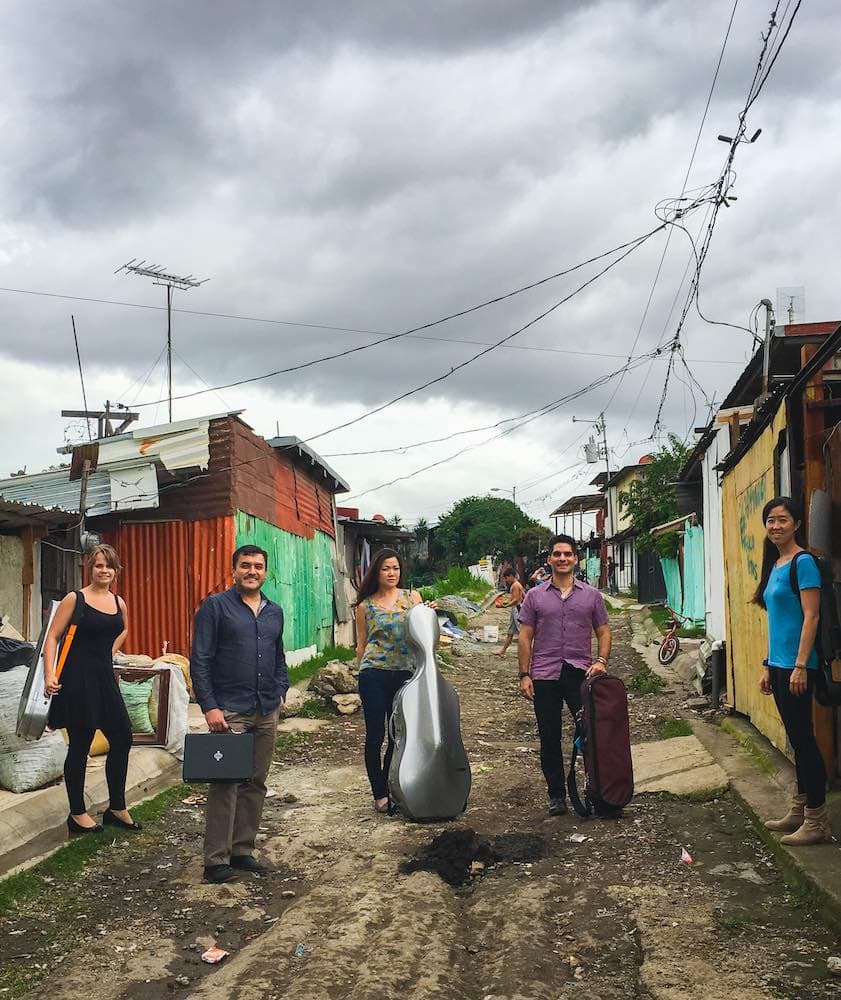In a typical year, Sound Impact reaches some 8,000 students throughout the United States and Central America. But typical, 2020 is not. The upheaval brought on by the pandemic left this collective of chamber musicians and soloists undeterred. In just a few months, they designed a free web series that takes children on a journey through time and space to explore how music has evolved across cultures and centuries.
“Until this point, we didn’t know about producing something, making videos, performing online, being creative with what we had at home,” said co-founder Danielle Cho, an independent cellist who usually performs regularly with the National Symphony Orchestra (NSO), the Washington National Opera, and the National Philharmonic. So it’s equipped with just rudimentary gear and their boundless imaginations that 14 professional musicians created the raucous and informative “Time Travel Goes Digital.”
Fourteen musicians from the Sound Impact collective take us on journeys through time and space to discover the origins, history, and evolution of music in their ‘Time Travel Goes Digital’ web series. Video: Sound Impact.
The 10 episodes, each lasting only about 15 minutes, are based on a program the group previously presented at Music at Kohl Mansion near San Francisco and through its partnership with the NSO. Rather than create digital content to replicate the live experience, Sound Impact transcends it with the series. The first few episodes introduce children to the basics of musical language and various instrument families, mostly relying on the music of Bach, Beethoven, and Brahms. Fair enough.
But the tightly packaged series quickly moves beyond the standard fare, organically integrating non-Western music and works by women and other underrepresented composers. On a topic like “overcoming adversity,” viewers learn about not only Beethoven’s deafness but also British suffragette Ethel Smyth, the Metropolitan Opera’s first African American soloist Marian Anderson, or Florence Price, the first female composer of color to have a symphony performed by a major American orchestra.
“Being a Black female from Jamaica with a biracial daughter, I have to relate to something,” said special education teacher Keisha Johnstone, whose colleagues and students also hail from multiple racial and cultural backgrounds. “To be able to see that there’s so much more out there, so many females doing things you’re not used to seeing them doing, it’s empowering.”

Most of the material was filmed inside the professional musicians’ own homes, creating a sense of scrappy intimacy rarely seen before the pandemic. From their living room, backyard, or neighborhood park, they take us on journeys through time and space to discover the origins, history, and evolution of music. Musical jokes abound, set against a backdrop of history and vignettes.
The production team worked across three different time zones with a producer based in Spain and presenters on both U.S. coasts. A budget of just $11,000 went mostly toward production and compensating performers. Thanks to the digital format, they featured living composers, instrument makers, and other musicians in various locales while reaching a much wider audience. The series has already garnered more than 5,000 views, including educators as far away as New Zealand. Plans are underway to expand the series and develop additional online content that could complement future in-person engagements.
“This time has just given us a wealth of opportunities, new growth, new friendships, new perspective,” said Cho. “Of course, there are challenges and it’s not always easy. As an organization, it makes you think outside the box.”

The musicians themselves are an eclectic bunch with ties to Asia, Europe, the Americas, and the Caribbean. In episode 6, violinist Regino Madrid talks about his native Philippines while wearing the traditional barong tagalog shirt made of pineapple leaf fibers. He performs with Cho and violist Jerome Gordon the popular kids’ folk song “Bahay Kubo” (Nipa Hut), composed by Felipe Padilla de Leon (1912–1992), who studied at New York’s prestigious Julliard School. Bandoneon player Javier Cárdenas, from Argentina, talks about this portable organ’s origins in Germany before segueing into the Quinteto Latino wind quintet performing an arrangement of tango revolutionary Astor Piazzolla’s “Libertango.”
Teaching in an all-virtual setting is challenging for teachers. It’s exponentially more difficult when the students have severe developmental disabilities. And yet Sound Impact’s program “was able to captivate” students and help them retain in-depth knowledge, said Johnstone. To explain tempi, Gordon, the violist, walked, ran, and sprinted on the lawn to the beat of various tunes. Music, as violinist Juan Jaramillo says in one episode, “is all around us.”
“It’s the characters, it’s the graphics, the fact that they were actually playing their own instruments,” added Johnstone, who teaches at Marcia D. Smith School in Gaithersburg, Maryland, under the umbrella of Community Support Services. “It became personable because you saw them in their own homes. It was not just like watching a video, but you felt like you were part of it. It wasn’t just, here’s an instrument, but here’s how it relates to our culture, where did this instrument come from.”
The ability to connect is innate for this set of musicians whose origin story lies in a 2012 performance that moved audiences in ways they had never experienced before. The three co-founders played a specially commissioned piece by Polina Nazaykinskaya, “Haim,” honoring the life of the late David Arben, a Holocaust survivor and former Philadelphia Orchestra associate concertmaster who taught Jackson. Each performance brought people together. “It was all with the desire to take our love of chamber music and create a bigger impact in the world,” Richardson recalled.

Since its formal launch in 2013, the organization has put community engagement at the forefront, connecting with hospitals, schools, homeless centers and juvenile detention centers. In Costa Rica, Sound Impact started a music festival in one of the country’s most destitute areas, La Carpio, located next to San José’s huge landfill. They donated instruments and music materials, taught master classes, organized concerts, and offered scholarships to visit the U.S. In coordination with the Foundation for the Advancement of String Education (FASE), local teachers received intensive training. A separate program is underway with Panama’s Funsincopa, including online courses popular across Latin America.
“Our three words that we like to use are connect, engage, and empower, and that’s really our mission, also to take music outside of the concert hall,” said Cho. “We really want to break down cultural barriers, and bring hope and light through the music.”
The kid favorite “Frozen” serves as an example of how films use music, while a string trio performs the sequel’s song “Into the Unknown.” Emmy Award–winning television composer John Wineglass then speaks about his craft and creates a new, Christmas-inspired piece on the spot. In a male-dominated field, the series is also quick to point out that only four women have received Oscars for their compositions. Regina Harris Baiocchi makes an appearance, explaining that “composing music is like writing a love letter to family and friends and for posterity.” And collective members play Jessica Meyer’s “I Only Speak of the Sun,” inspired by a Rumi poem.
Tiffany Richardson, a violist who co-founded Sound Impact with Cho and violinist Rebecca Jackson, said the series provides levity in an otherwise challenging period. “It’s actually really great to be a small, young, flexible organization,” with an annual budget of just $65,000 and no salaried employees.
“Sometimes that comes at a disadvantage, but during these times, it’s allowed us to be really nimble and innovative, and provided us flexibility to just pivot very quickly and work with our team wherever they are,” Richardson added. “It’s given everyone an opportunity to really be themselves in a different way, which musicians don’t always get when we’re on a concert stage.”
In order to help explain some of the trickier concepts, the musician-hosts created colorful characters like “fine musical art and facts collector” Professor Fiddlestein and Bridgette Jones, whose wooden bridge compatriots help create sound by bearing the weight and tension of strings on instruments like the violin or double bass. Dr. Counterpoint shows how several melodies are played against one another. He makes Baroque sound “cool,” while wearing a backwards baseball caps and shades.
The man behind the character, Robin Whitehouse, is also a multi-instrumentalist who explains the workings of a harpsichord by demonstrating at the keyboard and showing the individual parts of an instrument he built himself. He then performs a piece by British abolitionist Charles Ignatius Sancho, who was born on a slave ship in the Atlantic around 1729. In August, Whitehouse lost tens of thousands of dollars’ worth of audio engineering equipment and instruments in a Santa Cruz wildfire. Despite the added hardship, he kept handling the series’ audio mastering and even made repeat appearances in character.
The pandemic, Richardson concluded, “helped us innovate in ways we never thought of before.” The collective has grown, clinching new partnerships with schools and arts organizations. Public access television channels in Washington and in Alexandria, Virginia, are showing “Time Travel.” Eight public school systems have signed up to use the program in Virginia, New York, and California, with additional partnerships in the works. Some schools will also get ukulele instruction or music assemblies as part of tailored programs. Educators have access to additional accompanying educational materials in both English and Spanish adapted to various age groups through sixth grade, and the episodes have closed captioning as well.
Sound Impact took its ukulele class, Little Ukes & Friends, online for kids in the 4–8 set. Beyond introducing basic chords and strumming patterns, staff brought in living composers and international performers of various genres.
The pandemic has brought unprecedented innovation in classical music, a field too often seen as stale, austere, and anachronistic. That’s also because there are few other options for viability at a time when concert halls and even alternative venues have fallen silent, closed to the public indefinitely. There have been unusual collaborations, a cellist playing on Paris rooftops and in empty museums, endless livestreams from empty halls, or students from around the world performing with professional musicians in virtual concerts.
“A lot of musicians are stuck in ‘this is the only way you can be successful,’” Cho said. “I think now, as a 21st-century musician, we have to be thinking there are other ways to create revenue, to create income, and do what you love.”
About Sound Impact pre-pandemic (video produced by David Neidlinger)





Such an inspiring article! It´s wonderful to know there’s such type of artists, passionate and willing to share their knowledge and motivation with others. The youngest really need much more of this type of learning and self-growth!!